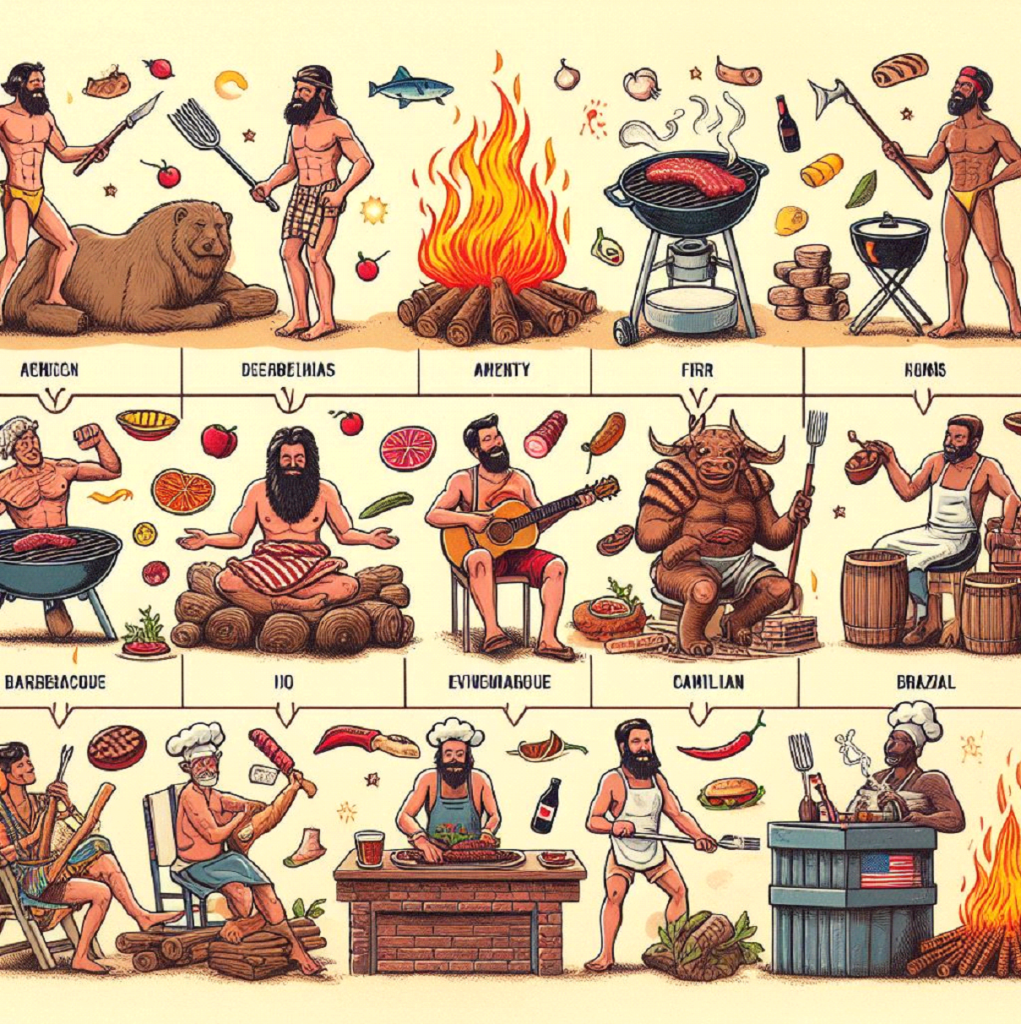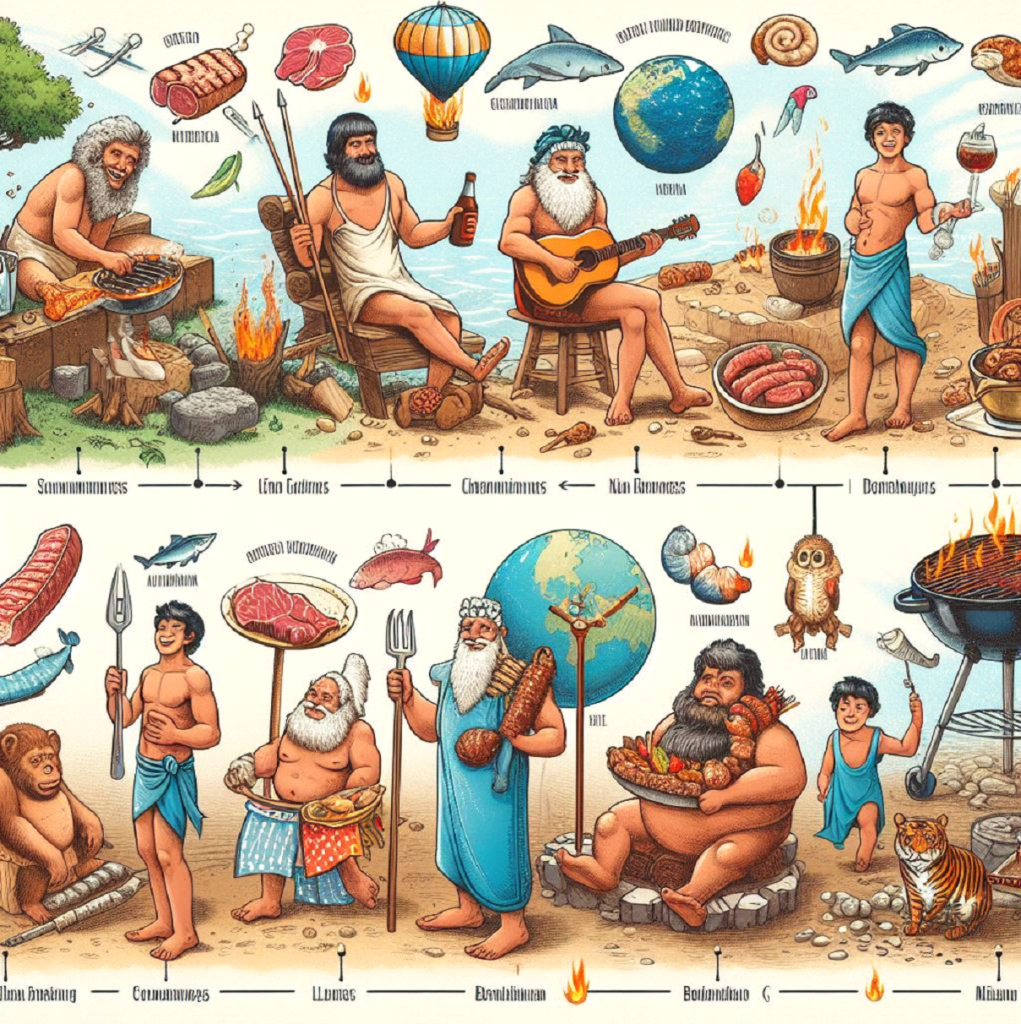History of barbecue
BBQ is not only a style of cooking but also a historic and cultural experience that has been passed from generation to generation throughout the centuries across the globe. The saga of barbecue is a tasty tale of a culinary evolution transformed by different influences, regional trends, and the mutual desire for the sweetness of slower cooking and the rhythm of the smoke. Whether it was a discovery made by the earliest people who cooked food over open flames or today’s barbecue masters who have evolved the art to a level close to fine art, this conclusive expedition has always been a symbol of our inherent desire to gather around a spinning wheel of fire and celebrate what we have achieved.

The Origins of Barbecue
The history of barbecue is something that started in the far past years; it all traces back to the origins of humans and when they accidentally discovered the wonderful transformative factor of fire. Our ancestors have been cooking love over ancient fires, which may have led them to hear even earlier, which could be a means of preservation as well as enhancing flavor. It was not only such a practical provision at those times; it also started a pattern of social gatherings and feasts with people as models.
When civilizations took off and men spread beyond geographic regions, the history of barbecue took on each region’s distinctiveness and cultural traditions. The islands of the Caribbean were the neighbors of the Taíno people, who used a type of grill called “barbacoa,” which entailed cooking meat slowly over a wooden platform raised above the ground. On the other hand, this method resulted in the word “barbecue,” which we use today, to define it accurately.
The Impact of Colonization as well as Out-Migration on the Culture and Language of Indigenous People.
The era of colonization and migration of countries left a huge mark on the past of barbecue. The need to create food from limited resources led to the usage of African traditions, which were fully used by the slaves in the Caribbean and South America. This mixture of African methods that the Native Americans and Europeans introduced led to the roots of our current abundant barbecue traditions, which are specifically tied to the US states of Carolina, Texas, and Kansas City.
The regional styles of barbecue, which reflect the doings in each region of the country, are a clear indication of the immense diversity of the culture.
The mastery of culinary skills becomes the source of local pride that reflects the varied history of barbecue. Every geographical location has examined the world in its distinctive way by using local ingredients, cultural background, and personal taste.
Texas-Style Barbecue: Rib-eye is the main course in Texas, where no other hero beats a hero of brisket. As simple as dry rub and a sprinkling of rub spice, Texas barbecue is then slow-smoked for over ten hours with no less than oak or mesquite wood, leading to a mouthwatering bite of thick, smoky sauce on the sides.
Kansas City-Style Barbecue: Besides the sweet and sour relish sauces that are unique to this place, the Kansas City barbecue tradition involves the use of various types of meat, including ribs, pulled pork, and burnt ends. It is usually made with tomatoes and then mixed with a combination of several spices and molasses.
Memphis-Style Barbecue: This method is made up of the dry spice rub, where some special mix of spices is thrown over the food and then smoked. In our hometown, ribs are a must-have meal, typically with a feisty sauce made from mustard.
Even though heat was mostly the only source for cooking food for most of human history, barbeque can be classified as a fusion of technology and art. This is because, with the introduction of methods and innovative equipment such as smokers, barbeque has been propelled to a whole new level.
The art of barbecue has changed throughout its history to suit your tastes and adapt to the changing lifestyles and tastes of people. While faith in pit smoking exclusively belongs to serious pitmasters, it is now rendered more called for by techniques such as kettle grilling and the use of electric smokers. However, among many purists, the traditional offset smokers as well as the stick burners continue to be a must-have’, because only with them can the true flavor of the cooking process be preserved, as without them this flavor might be lost forever.
Barbecue Recipes and Methods
A quintessential part of the barbecue tradition is the deep-rooted history, which tells the story of recipes and methods that spanned the generations. Each region boasts its signature dishes and techniques, but the essence of barbecue remains the same: using slow and low fire, being a skilled wood master, and sensing the specific moment to add smoke and spice.
For example, a very famous barbecue dish is exactly the Texas brisket. This has started with a great dry rub followed by hours of slow smoking over oak or mesquite wood, the essential part of a flavorful BBQ imprinted in humans´ DNA. The end product delivers a romantic, smoky experience that combines the savory depth of a long and slow process with the wonderful bark on top.
In the Carolinas, the meat of a whole pig cooked over wood is known as whole hog barbecue. This beloved tradition of smoking an entire swine over hardwood coals, mopping it with a saucy vinegar-based marinade, and carving it to perfection after grilling it to your ultimate love has always been a major part of this event.
When talking about Kansas City, one cannot leave out the infamous Burnt Ends. Unlike the healthy traditional cut of meat, the burnt ends represent the fattiness and delicious caramelized ends of a smoked brisket. These small snacks are frequently dipped in sweet, tangy sauce to make them a delicacy, either as an add-on or as a starter.
Also in Memphis, we dry-rub ribs, making a whopping success of the night. A meticulously curated seasoning blend containing an ample amount of various spices is generously applied all over the meat before smoking, giving the end product a beautiful crust that enhances the meat’s already tender, succulent body.
Conclusions about History of barbecue
Barbecues have a great history that stretches between different peoples and continents until the present day. From its humble roots as merely a process of preservation to its current level of aesthetic achievement, barbecue has come to be the glue that binds us together, engaging us in the timeless tradition of basking in the glow of the fire of our own making. It doesn’t matter whether you’re a purist who believes in conventional ways or a modernist who embraces the latest techniques; the attraction of barbecue is in its ability to transport us in time and knit us together as one band to achieve exquisite, tender perfection.

FAQs about History of barbecue
How can one differentiate between different types of regional barbecue styles in the United States?
The major regional types of barbecue in the United States include Texas-style (sliced beef brisket), Carolina-style (whole pig slow-roasted), Kansas City-style (sweet and tangy sauces), and Memphis-style (dry rubs with pork ribs).
Αφήστε μια απάντηση